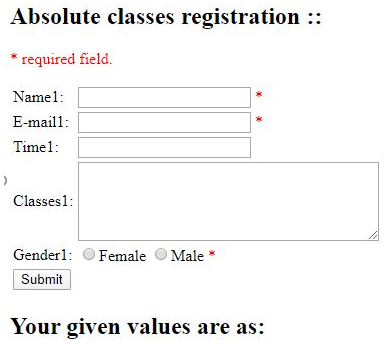Updated July 1, 2023

Introduction to PHP Form Validation
PHP Form may contain different types of validation techniques. In many cases of PHP Form Validation “*” symbol is used for the mandatory & required fields. There are different types of validating a task. PHP will do the content processing from a FORM of content, but the form will be made using HTML. In-text, The PHP Form may contain different types of inputs. It may contain text fields, radio buttons/buttons, a Selection list with multiple options, checkboxes, submit buttons, etc.
Various Form Validation in PHP
There is various Form Validation in PHP Programming Language techniques that will help us a lot in invalidation. Suppose if you have entered any wrong thing, errors will be omitted/highlighted with a message along with the relevant field.
There are two types of validation available in the PHP web language. =
1. Client-Side Validation: In Client-side validation, Validation will be performed on the client web applications like browsers/any other.
2. Server-Side Validation: In Server-Side Validation, Validation will be performed in the server machine after data is submitted, and this data will be sent to the server to validate.
Fields that are used for the validation rules:
- Name: This field is mandatory in the PHP form. It should contain only whitespace and letters.
- EMAIL: This is also a mandatory field like the NAME field in a PHP form. It should contain only a specific valid EMAIL ADDRESS with “@” and. “In the middle of the text.
- Website: This is not a mandatory field like the EMAIL field. It is an optional field. If this website field has some text, it should be a valid URL ADDRESS.
- Comment: This is also an optional field, but it contains a Multi-line input field(text inputs area)
- Gender: It is a mandatory field just like the NAME and EMAIL fields. It allows us to select only one option from two, three, or more options. Only two select options will be provided in the PHP FORM most of the time.
Text Fields of the PHP FORM
Normally the syntax will look like this:
Syntax:
Name1: <input type="text" name="name1">
E-mail1: <input type="text" name="email1">
Website1: <input type="text" name="website1">
Comment1: <textarea name="comment" rows="6" cols="40"></textarea>Explanation:
The above-mentioned html form elements are used to grab/specify the text content. If you observe, for each input type “text” is defined so that those elements are defined as text input elements.
Radio Button Fields/Elements
There are only some fields that accept radio buttons (select options), and the basic HTML code looks like this:
Syntax:
Gender1:
<input type="radio" name="gender1" value="female">Female1
<input type="radio" name="gender1" value="male">Male1
<input type="radio" name="gender1" value="other">Other1HTML FORM element
The HTML FORM element mostly accepts two specific attributes. They are action and method attributes.
Basic Syntax of HTML FORM:
<form name='test1' method='POST' action='' accept-charset='UTF-8'>
Name1: <input type='text' name='Name1' size='20'>
Email1: <input type='text' name='Email1' size='20'>
<input type='submit' name='Submit1' value='Submit'>
</form>The output of the above Syntax:
![]()
Select List Field & Submit Button Field
It will provide some options for multiple options selections, like selecting vegetables for home from the market or selecting different types of fruits from many types of fruits.
Syntax of Select List:
<form name='test1' method='POST' action='' accept-charset='UTF-8'>
Select Fields Looks like this ::
<br>
<select name="requiredVegetables[]" size="4" multiple>
<option value="Tomato">Tomato</option>
<option value="brinjal">Brinjal</option>
<option value="drumsticks">Drumsticks</option>
<option value="Carrots">Carrots</option>
<option value="Onion">Onion</option>
<option value="Beetroot">Beetroot</option>
</select>
<input type='submit' name='Submit1' value='Submit'>
</form>The output of the above Syntax:

To validate the PHP FORM, at the starting point of the HTML, one has to place $_SERVER[“REQUEST_METHOD”]. If REQUEST_MODE has POST as a value, then you will know that the PHP script is submitted. We can also use GET as a value of some different characteristics.
Validating the PHP FORM contents
Here is the value of “$_SERVER[“PHP_SELF”].” PHP_SELF contains the filenames of the PHP programming script which will be executed. PHP_SELF is one of the superglobal variables which will return the filename of the currently executing programming script. bmitted. Here the value of “so use GET as value electing dif$_SERVER[“REQUEST_METHOD”] is used to know whether the script is submitted or not. HERE “POST” value is used for the REQUEST_METHOD.
Example:
This is an example of PHP Form Validation. The filter_var() function filters the variable with the help of the specified filter. Check out the output below so that you can understand.
Syntax:
<html>
<head>
<style>
.error {color: #FF0000;}
</style>
</head>
<body>
<?php
$nameErr1 = $emailErr1 = $genderErr1 = $websiteErr1 = "";
$name1 = $email1 = $gender1 = $comment1 = $website1 = "";
if ($_SERVER["REQUEST_METHOD"] == "POST") {
if (empty($_POST["name1"])) {
$nameErr1 = "Name1 is required";
}else {
$name1 = test_input($_POST["name1"]);
}
if (empty($_POST["email1"])) {
$emailErr1 = "Email1 is required";
}else {
$email1 = test_input($_POST["email1"]);
if (!filter_var($email1, FILTER_VALIDATE_EMAIL)) {
$emailErr1 = "Invalid email1 format";
}
}
if (empty($_POST["website1"])) {
$website1 = "";
}else {
$website1 = test_input($_POST["website1"]);
}
if (empty($_POST["comment1"])) {
$comment1 = "";
}else {
$comment1 = test_input($_POST["comment1"]);
}
if (empty($_POST["gender1"])) {
$genderErr1 = "Gender1 is required";
}else {
$gender1 = test_input($_POST["gender1"]);
}
}
function test_input($data1) {
$data1 = trim($data1);
$data1 = stripslashes($data1);
$data1 = htmlspecialchars($data1);
return $data1;
}
?>
<h2>Absolute classes registration ::</h2>
<p><span class = "error">* required field.</span></p>
<form method = "post" action = "<?php
echo htmlspecialchars($_SERVER["PHP_SELF"]);?>">
<table>
<tr>
<td>Name1:</td>
<td><input type = "text" name = "name1">
<span class = "error">* <?php echo $nameErr1;?></span>
</td>
</tr>
<tr>
<td>E-mail1: </td>
<td><input type = "text" name = "email1">
<span class = "error">* <?php echo $emailErr1;?></span>
</td>
</tr>
<tr>
<td>Time1:</td>
<td> <input type = "text" name = "website1">
<span class = "error"><?php echo $websiteErr1;?></span>
</td>
</tr>
<tr>
<td>Classes1:</td>
<td> <textarea name = "comment1" rows = "5" cols = "40"></textarea></td>
</tr>
<tr>
<td>Gender1:</td>
<td>
<input type = "radio" name = "gender1" value = "female">Female
<input type = "radio" name = "gender1" value = "male">Male
<span class = "error">* <?php echo $genderErr1;?></span>
</td>
</tr>
<td>
<input type = "submit" name = "submit1" value = "Submit">
</td>
</table>
</form>
<?php
echo "<h2>Your given values are as:</h2>";
echo $name1;
echo "<br>";
echo $email1;
echo "<br>";
echo $website1;
echo "<br>";
echo $comment1;
echo "<br>";
echo $gender1;
?>
</body>
</html>Output:

Conclusion
I hope you learned what the definition of PHP Form Validation is, Various Form Validation in PHP Programming Language in detail, along with various examples of different types of input methods in PHP Form to ensure the validation is perfect and to understand the concept.
Recommended Articles
This is a guide to PHP Form Validation. Here we discuss the various forms of Validation in PHP along with programming examples for better understanding. You may also have a look at the following articles to learn more –


